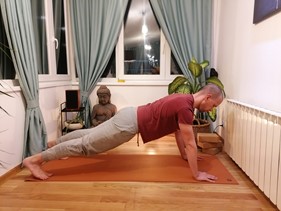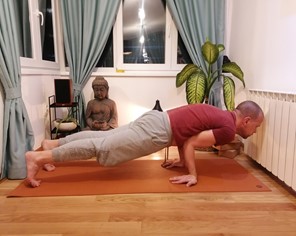The name of this pose in Sanskrit is Hamsasana. Hams in translation means swan and Asana means pose.
A DEEPER INSIGHT
The pose itself belongs to the group of balancing asanas. With respect to the difficulty of the Asana itself, it can be said that the swan pose is an intermediate level asana.
Since the white color of the swan represents love and peace, it is believed that every person who practices this asana deepens their sense of love, compassion for other beings, and of course, a sense of respect.
It is believed that by practicing this pose, the practitioner is completely freed from any doubts and insecurities in his or her life. As a result, a person becomes more confident in himself as well as in the life he lives.
If you practice this asana, the third chakra or Manipura is stimulated. The mantra for this chakra is RAM. The element is fire and the color is yellow.
The swan is considered a sacred animal. According to Indian mythology, the swan is the vehicle of the goddess Saraswati. Saraswati is the goddess of knowledge and the creative arts.
PRACTICE AND BENEFITS
Before including this pose in your practice, it would be advisable to prepare the body for it, considering that it is still a balanced pose.
Having that fact in mind, we put the emphasis first of all on the wrists and the tendons of the hands. In my opinion, these should be the starting points when it comes to practicing this pose. It goes without saying that your wrists are well warmed up and that the hamstrings are well stretched. Otherwise, the sprains or strains (of wrist joints or tendons) can easily occur. Therefore, warm up your wrists well with the help of rotation exercises (up, down, left, and right) and stretch the tendons of your hands by placing your palms on the yoga mat and turning your fingers towards your body.
If your palms are down on the entire surface of the yoga maat, you can try to move your palms forward, that is, away from the body. In this way, you additionally stretch the tendons of the arms.
In the first pose, when you stretch the hamstrings, the wrists are located directly under the shoulders. In the second pose, which is a more demanding pose, the wrists are located diagonally in relation to the shoulders; since you started with the palms forward, the wrists are no longer directly in front of the shoulders.
The pose itself strengthens and improves the flexibility of the wrists and hands. Given that it is a balanced pose on the hands that are in the navel area at the time of performing the asana itself, the swan pose is excellent for massaging the stomach and organs inside the abdominal cavity. That being said, in most cases, the practioner’s metabolism will improve and the entire digestive system will function significantly better.

We also advise you to practice the oblique plank and chaturanga. Since the swan is also a pose of strength, it is very important to develop the strength of your arms and shoulders. You can practice the static poses of these two poses. But you can also combine them into one micro-motion, moving from the oblique plank to the chaturanga, and returning from the chaturanga to the oblique plank.
In case you don’t have enough strength to return from chaturanga to the oblique plank, feel free to lower your knees to the yoga mat to lift your upper body. The very important parts in this variation are the toes. Do not allow the toes to lift, so they are on the yoga mat the whole time; you literally push the yoga mat with your toes. In that way, you get an extra boost but you also develop your stamina and endurance.
During the practice of the oblique plank and chaturanga, use the uddiyana and mula bandha. Using these two bandhas (muscle contractions), you will stay in the same poses longer and easier.
Another great pose to practice before entering the swan pose is the dolphin pose. Practicing this pose primarily strengthens your shoulders, upper arms, and forearms.
To enter the swan pose itself, after warming up the wrists and stretching the tendons of the arms and legs, enter the pose itself gradually, step by step. Place your elbows slightly above the navel; your upper arms rest on the space between the navel and the chest. Place your palms all over the yoga mat with your fingers pointing in the direction of your feet. Stretch your back, stretch your legs, and lean on your toes. In this pose, you can take ten or twenty inhalations and exhalations.

You can also insert a light movement in this pose during which you transfer the entire weight of your entire body to your palms. To achieve this, gently slide your body forward, shifting your body weight from your toes to your palms.
At the moment when you feel that you have enough strength and your sense of balance is no longer in question, lean all the way forward, lifting your legs up. Bring your legs together if you can and for an added balance, try to stretch your toes back as far as possible. The legs are fully stretched, and the same applies to the back. Remember to use the uddiyana and mula bandha all the time. It is also very important to focus while practicing this Asana. Concentrate your attention on one point in front of you, one meter or one meter and a half away. Lift alternately, first by one foot then the other until you can completely separate your feet from the yoga mat.
You can also use the block as a support for your toes. You can also rest your soles on the wall. In this way, you will completely shift your attention to the placement of your hands and palms, thus practicing and gradually preparing your upper body to perform the full pose.
If you make this asana a part of your daily yoga routine, you can expect your digestive organs to function much better. Practicing this pose stabilizes the pressure in the ears since it leads to the opening of the Eustachian tube. Strengthening the immune system and calming the mind are also the benefits that a practitioner can achieve by practicing this asana.
You should certainly not forget about the activation of the Manipura chakra.
CONCLUSION
Sometimes, people are not even aware that a certain asana can help them. Therefore, if you have problems with digestion, diabetes, the pancreas, the colon, or ulcers, the swan pose is definitely an asana that you should practice.
If you are also currently facing any insecurity or doubt in your life, start practicing the swan pose. Of course, if you cannot perform it in its full pose, try its variations. We believe that you will feel the benefits of this asana very quickly.







